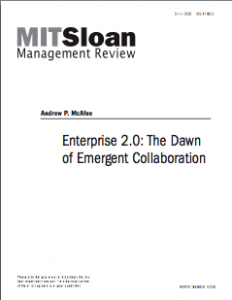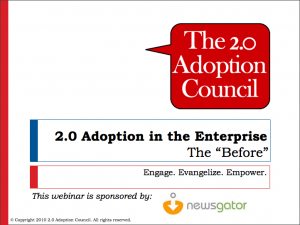 Enterprise 2.0 was launched in the spring of 2006 as a result of Andrew McAfee’s case study interviews in 2005 on Dresdner Kleinwort Wasserstein (DrKW), an investment bank in London. The story unfolded after he and his team studied the work of J.P. Rangaswami, who was then Global CIO of the bank. It’s sometimes surprising to me when I realize how much has changed since those early days. For starters, the technology foundation of the DrKW case study was wikis (Socialtext), blogs (b2evolution), and messaging software (MindAlign). Of these three, only Socialtext is what I would consider top-of-mind in the E20 sector (and the company’s software has extended well beyond an enterprise wiki.) J.P. Rangaswami even left DrKW and has successively mastered several positions at BT where he is now Chief Scientist.
Enterprise 2.0 was launched in the spring of 2006 as a result of Andrew McAfee’s case study interviews in 2005 on Dresdner Kleinwort Wasserstein (DrKW), an investment bank in London. The story unfolded after he and his team studied the work of J.P. Rangaswami, who was then Global CIO of the bank. It’s sometimes surprising to me when I realize how much has changed since those early days. For starters, the technology foundation of the DrKW case study was wikis (Socialtext), blogs (b2evolution), and messaging software (MindAlign). Of these three, only Socialtext is what I would consider top-of-mind in the E20 sector (and the company’s software has extended well beyond an enterprise wiki.) J.P. Rangaswami even left DrKW and has successively mastered several positions at BT where he is now Chief Scientist.
In short, Enterprise 2.0 is maturing. It’s high time for a new series of case studies. This week, McAfee (today, speaking at SXSW) and I are announcing The 2.0 Adoption Council and MIT’s Center for Digital Business will be co-producing a series of case studies that explore the modern dynamics driving the 2.0 phenomenon in a sampling of large enterprises. We’ve identified the following themes that are present in most initiatives:
- Innovation: Leveraging collaboration and social activity to spur discovery, idea generation, and breakthroughs for the organization or customers
- Time-to-Market: Accelerating the time to bring products/services to market by collapsing artificial silos/boundaries and time zones
- Cultural Reinvention: Using the philosophies of 2.0 to reshape the organizational DNA, embracing transparency, collaboration, trust, and authenticity
- Visibility: To provide a real-time view into operations and business process by connecting people and ideas.
- Cost Reduction: Substituting more agile, lightweight tools for connecting and sharing that are easier to manage and significantly reduce operational cost.
- Knowledge-sharing: Harvesting institutional knowledge of the enterprise for the purposes of retaining it, exposing it and providing easy access to it.
- Expertise location: Indexing and surfacing hidden and known talent in the Enterprise.
- Productivity improvement: Providing socio-collaborative tools to the workforce for measurable gains in productivity.
- Talent Retention: Providing tools that add to workplace satisfaction and positive employee work experience, especially germane to retaining GenX and GenY talent.
Each case study, written in a detailed contextual narrative, will highlight at least one of these themes. Our goal is to produce approximately a dozen solid case studies from different industry sectors. We will be delving into the business rationale for each case, its particular adoption strategy and status, as well as the expected business results. We hope to be able to discuss the progress on these case studies at the Enterprise 2.0 conference in mid-June. As soon as I have secured our sponsor commitments, work will begin immediately.
If you have suggestions for the case study series, I’d love to hear them.




